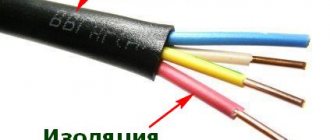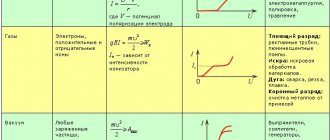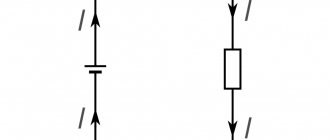Today it is difficult to imagine your life without electricity, but in order to use all the benefits of electric current during the installation of electrical panels, transformers and other electrical installations, you need to adhere to the basics of electrical safety and know how to protect against voltage.
Methods of protection: general characteristics
Today there are several methods of protection against electric current, and they depend on the electrical installation.
Thus, the following protective measures can be distinguished:
- grounding;
- zeroing;
- shutdown;
- network separation;
- insulation;
- alignment;
- use low voltage.
These types of protection can be used either individually or in combination with each other. For example, in electrical installations with a voltage of 1000 V, grounding can be combined with insulation or with protective disconnection. If a transformer or other installation uses voltages up to 1000 V and above 1000 V, then it is recommended to apply winding insulation between these two voltage types. To do this, you can use special adapters that allow you to control differences. Adapters can be installed on each phase responsible for supplying a lower voltage.
If the electrical installation has 1000 V and a solidly grounded neutral is used, then protection methods such as grounding or disconnection can be used. Protective shutdown can be used as a main method of protection or as an auxiliary one.
General informationThere are the following protection methods, used separately or in combination with each other: protective grounding, grounding, protective shutdown, electrical separation of networks of different voltages, use of low voltage, insulation of live parts, potential equalization.
In electrical installations (EI) with voltages up to 1000 V with an isolated neutral and in DC EIs with an isolated midpoint, protective grounding is used in combination with insulation monitoring or protective shutdown.
In these electrical installations, a network with a voltage of up to 1000 V, connected to a network with a voltage above 1000 V through a transformer, is protected from the appearance of high voltage in this network if the insulation between the low and high voltage windings is damaged by a breakdown fuse, which can be installed in each phase on the low voltage side transformer.
In electrical installations with voltages up to 1000 V with a solidly grounded neutral or a grounded midpoint, grounding or protective shutdown is used in DC power plants. In these electrical installations, grounding the housings of electrical receivers without grounding them is prohibited.
Protective shutdown is used as a primary or additional method of protection if safety cannot be ensured by using protective grounding or grounding or their use causes difficulties
If it is impossible to use protective grounding. After grounding or protective shutdown, servicing of the power plant from insulating platforms is allowed.
Protective grounding
Grounding (Fig. 4.7) is the connection to the ground of non-current-carrying metal parts of electrical equipment through metal parts laid in the ground and called grounding conductors, and parts laid between grounding conductors and electrical equipment housings, called grounding conductors. Conductors and ground electrodes are usually made of low-carbon steel, colloquially called iron.
Grounding electrodes in the form of pins driven into the ground are called electrodes, and can be single or group. The ground electrode has characteristics determined by the flow of current through it into the ground. The characteristics of the ground electrode include:
- voltage on the ground electrode;
- change in the potentials of points in the ground around the ground electrode depending on their distance from the ground electrode in the current spreading zone - type of potential curve;
- type of lines of equal potential - equipotential lines on the surface of the earth;
- resistance of the grounding device;
- touch and step tension.
In Fig. Figure 4.8 shows a diagram of a simple ground electrode in the form of a rod or pipe driven into the ground and a view of the potential curves and equipotential lines.
At a distance of less than 40 m between single grounding conductors in a group grounding conductor, their spreading zones overlap each other, and a single spreading zone of a group grounding conductor is obtained, which has its own potential curve.
Touch voltage
Touch voltage is the voltage on the body of electrical equipment with damaged insulation that can be touched by a person. This voltage depends on the state of the grounding, the distance between the person and the ground electrode, and the resistance of the base on which the person stands.
In Fig. 4.9, o shows the influence of the position of a person relative to the ground electrode with a single ground electrode on the magnitude of the touch voltage. Touch voltage is maximum in position 1
a person when he stands in the zero potential zone and touches grounded equipment;
equals zero at position 2,
when a person stands on a ground electrode or its projection onto the surface of the earth, in some intermediate position of the person the touch voltage has an intermediate value, which varies from O to U3.
In Fig. 4.9, b
The dependence of touch voltage on the position of a person with a group grounding is shown.
In this case, Upp
has the greatest value in position
1
of the person, when he is between the electrodes of the ground electrode, the lowest value in position
2,
when he stands on the ground electrode or its projection onto the surface of the earth, in any intermediate position Upp varies from 6 to the maximum value.
Step voltage
Step voltage occurs between the legs of a person standing on the ground due to the potential difference on the surface of the earth when a ground fault current spreads in the ground. There is no step voltage if a person stands either on a line of equal potential or outside the current spreading zone, i.e., at a distance of more than 20 m from the ground electrode.
In Fig. Figure 4.10 shows the dependence of the step voltage on the distance between a person and a single ground electrode. The step voltage is greatest in the position of 1 person, when he stands with one foot on the ground electrode. In the position of a person between the ground electrode and the zero potential zone, when the step is directed radially towards the ground electrode, the step voltage has an intermediate value.
Grounding is intended to eliminate the danger of electric shock to a person when touching non-current-carrying parts that are energized. This is achieved by reducing the touch and step voltages to safe limits due to the low resistance of the ground electrode. The scope of application of protective grounding is AC and DC networks with an isolated neutral of the voltage source or transformer.
AC electrical installations with voltages up to 42 V and DC electrical installations with voltages up to 110 V do not require protective grounding.
The resistance value of the grounding device is standardized by the “Electrical Installation Rules” (PUE). This value for electrical installations up to 1000 V with an isolated neutral should be no more than 4 ohms, and if the power of generators or transformers supplying the network, or their total power is no more than 100 kVA, then the resistance should be no more than 10 ohms.
For grounding, parts of existing structures can be used, which are called natural grounding electrodes:
- metal and reinforced concrete structures of buildings and structures in contact with the ground;
- metal pipelines laid in the ground, with the exception of pipelines of flammable liquids and gases;
- lead sheaths of cables laid in the ground;
- well casing pipes, etc.
The smallest sizes of artificial grounding electrodes:
- diameter of round electrodes, mm
- non-galvanized………………. 10
- galvanized……………….. 6
- cross-section of rectangular electrodes, mm^2 … 48
- thickness of rectangular electrodes, mm ... 4
- thickness of angle steel flanges, mm…….. 4
The following can be used as grounding and neutral (see below) conductors connecting equipment housings to grounding conductors:
- special conductors;
- metal structures of equipment and buildings;
- steel pipes for electrical wiring, aluminum cable sheaths;
- metal openly located pipelines for all purposes, with the exception of pipelines for flammable liquids and gases, sewage and central heating.
It is prohibited to use aluminum wires for laying in the ground, metal sheaths of tubular wires, support cables of cable wiring, metal hoses, armor and lead sheaths of wires and cables as grounding and neutral conductors.
The minimum dimensions of grounding and neutral conductors are shown in table. 4.2.
Table 4.2 MINIMUM SIZES OF GROUNDING AND ZERO CONDUCTORS
Conductors are connected to equipment bodies by welding or bolting, ensuring accessibility for inspection or alteration if contact deteriorates. Sequential connection of individual equipment enclosures to the grounding or grounding circuit is prohibited.
When installing grounding devices by the installation organization, control over the work is carried out by the customer. At the same time, works that will subsequently be hidden are accepted separately, and at this time, and not after, acts for hidden work are signed.
Installation organizations provide the customer with all documentation for grounding devices. A passport is issued for each device, which records all changes, results of inspections and measurements.
When checking the condition of the grounding, the visible part is periodically inspected, the circuit between the ground electrode and the grounded elements is checked, the resistance of the grounding device is measured, and the soil is selectively opened to inspect the elements located in the ground.
Measuring the resistance of the grounding device
Measurements are usually made using a special device - a grounding meter, for example, M-416, which works on the principle of an ammeter-voltmeter. When measuring the resistance of a complex circuit (Fig. 4.11, o), which has the largest diagonal D,
the current electrode
Et
is placed at a distance l1 = 2
D
from the edge of this circuit, and the potential electrode En is alternately at distances of 0.4, 0.6, 0.5l, recording the instrument readings
. If the resistances obtained when installing Ep at distances of 0.4 and 0.6l1 differ by no more than 10%, then take the resistance value obtained at the position of the potential electrode at a distance of 0.5l1, and if the difference is more than 10%, then either repeat the measurements at increasing the distance to Et
by 1.5...2 times, or making measurements when changing the direction of the current electrode.
For vertical electrodes arranged in a row and connected by a strip or for a ground electrode consisting of a strip, the length of the strip is taken as the value D.
Current electrode (Fig. 4.11, b)
located at a distance from the edge of the grounding conductor being tested:
at D >
40 m l2 = 2
D,
at 10 m <
D
<= 40 m l2 > 80 m,
at D<=
10 m l2 = 40 m.
The potential electrode is located at a distance of 0.54. Grounding resistance is measured when it has the greatest values: for the northern regions and the middle zone - in winter when the soil freezes the most, for the southern regions - when the soil is the driest.
During acceptance tests, the measured resistance values are multiplied by the seasonality coefficient, which is taken from the table.
Zeroing
Grounding (Fig. 4.12) involves solid grounding of the neutral of a three-phase current source or transformer, one output of a single-phase current source, the presence of a neutral wire and its re-grounding.
Grounding the neutral of the current source is intended to reduce the voltage on the equipment housings and on the neutral wire to which these housings are connected to a safe value when the phase conductor is shorted to ground, thereby creating a path for the current Iph-z (Fig. 4.12).
The neutral protective conductor is designed to increase the short circuit current lk in order to influence this current on the protection. The increase in lк occurs due to a decrease in current resistance in the presence of a neutral wire compared to if the current flowed through the ground.
Re-grounding of the neutral wire is intended to reduce the voltage on equipment housings when a phase is shorted to the housing, both when the neutral wire is working and when the neutral wire is broken.
Grounding in electrical installations up to 1000 V is used in 4-wire networks with a solidly grounded transformer neutral
motor and generator, in networks with a grounded output of a single-phase current source, in networks with a grounded midpoint of a direct current source. Grounding is performed in the same cases as protective grounding.
The maximum resistance values of grounding devices in the grounding system are given in Table. 4.3.
Table 4.3 LIMIT VALUES OF RESISTANCE OF GROUNDING DEVICES IN THE GROUNDING SYSTEM
Zero working conductors are used as neutral protective conductors, with the exception of conductors for mobile electrical receivers. In the circuit of neutral protective conductors there should be no devices that disconnect these conductors, including fuses.
Grounding is checked for compliance with the requirements of the PUE during installation, upon delivery after installation and during operation.
Check the following parameters:
resistance of neutral and repeated groundings;
the ratio of the current of a single-phase short circuit to the body and the rated current of the fuse link or the setting current of the circuit breaker in the controlled section of the network, and this ratio must be at least 3, and for circuit breakers with only electromagnetic releases for a rated current of up to 100 A, the multiplicity must be at least 1, 4 and for machines with a current of more than 100 A - 1.25.
Safety shutdown
A residual current device (RCD) consists of a sensitive element that responds to changes in the controlled value, and an actuator that turns off the corresponding section of the network.
The sensing element can respond to housing potential, ground fault current, zero sequence voltage and current, and operational current. Contactors, magnetic starters, automatic switches with independent releases, and special switches for RCDs can be used as switches.
The purpose of the RCD is to protect against electric shock by turning off the device when there is a danger of a short circuit to the equipment body or directly when a person touches its leading parts.
RCD is used in electrical installations with voltages up to 1000 V with an isolated or solidly grounded neutral as the main or additional technical method of protection if safety cannot be ensured by using grounding or grounding or if grounding or grounding cannot be performed for some reason.
An RCD is mandatory for monitoring the insulation and shutting down the power plant when the insulation resistance decreases in power plants for special purposes, for example, in underground mines (leakage relay).
An example of an RCD is a protective-switching device of the ZOUP-25 type, designed to disconnect and switch on three-phase power circuits at a voltage of 380 V and a current of 25 A in systems with a solidly grounded neutral, as well as to protect people when touching live parts or equipment housings that are energized .
Electrical separation of networks
Electrical separation of networks is carried out through a special isolation transformer, which separates the network with an isolated or solidly grounded neutral from the section of the network that supplies the electrical receiver. In this case, the connection between the power supply network and the receiver network is carried out through magnetic fields; the receiver network section and the receiver itself are not connected to the ground. The isolation transformer is a special transformer with a transformation ratio equal to unity, a voltage of no more than 380 V, with increased reliability of design and insulation. The transformer is allowed to power no more than one receiver with a current of no more than 15 A. Step-down transformers with a secondary voltage of no more than 42 V can be used as isolation transformers if they meet the requirements for an isolation transformer.
Using low voltage
Low voltage (no more than 42 V between phases and in relation to ground) is used for hand tools, portable and local lighting in any room and outside. It is also used in rooms with increased danger and especially dangerous for powering local stationary lighting fixtures, if they are located at a height of less than 2.5 m. A common voltage in use is 36 V, and in closed metal containers a voltage of no more than 12 V should be used.
Potential equalization
As is known, touch or step voltage occurs when there is a potential difference between the base on which a person stands and the equipment bodies that he can touch, or between the legs. If you connect through additional electrodes and conductors the places where the human body might touch, there will be no potential difference and no associated danger.
Potential equalization of electrical equipment housings and associated structures and foundations is carried out by installing a contour grounding electrode, the electrodes of which are located around a building or structure with grounded or neutralized equipment. Inside the contour grounding system, under the floor of the room or platform, horizontal longitudinal and transverse electrodes are laid, connected by welding to the circuit electrodes. If there is a grounding, the circuit is connected to the neutral wire.
Potential equalization of equipment frames and structures is carried out by connecting the structures and all frames to the grounding or grounding network.
Potential equalization is used as an additional technical method of protection in the presence of grounding or grounding in areas with increased danger or especially dangerous ones.
The use of potential equalization is mandatory in livestock buildings.
The potential equalization device is carried out according to the project.
Characteristics of protective grounding
Electrical equipment has a part where current flows and a part where there is no current. It is the part where there is no current that is grounded. For this, special parts and conductors are used. Typically, they are made of iron or low carbon material. There are several types of grounding. So, you can use special electrodes that look like pins. They are inserted into the ground. It is prohibited to use aluminum parts to provide grounding. It is important to periodically check electrical equipment and grounding conditions.
First aid for an electric shock victim
After releasing the victim from the action of electric current, it is necessary to determine his condition:
- consciousness: clear, absent, disturbed, agitated;
- color of the skin and visible mucous membranes (lips, eyes): pink, bluish, pale;
- breathing: normal, absent, impaired (irregular, shallow, wheezing);
- pulse in the carotid arteries;
- pupils are narrow and wide.
The color of the skin, the presence of breathing, and loss of consciousness are assessed visually. If the victim has no consciousness, breathing, pulse, the skin is bluish, and the pupils are wide, it can be considered that he is in a state of clinical death and it is necessary to immediately begin to revive the body using artificial respiration using the “mouth-to-mouth” or “mouth-to-mouth” methods. nose" and external cardiac massage.
If the victim breathes very rarely and convulsively, but his pulse is palpable, it is necessary to immediately begin artificial respiration.
Once you start reviving, you need to call a doctor or emergency medical help. If the victim is conscious, but was previously fainted or unconscious, but with stable breathing and pulse remaining, he should be laid on a mat, unbuttoned clothes, create an influx of fresh air, create complete rest, continuously monitoring the pulse and breathing.
Under no circumstances should the victim be allowed to move, much less continue to work, since there is no visible severe damage from electrical damage. current does not exclude a possible subsequent deterioration of his condition. The victim should be transferred to another place only in cases where he or the person providing assistance continues to be in danger or when providing assistance on the spot is impossible (for example, on a support). Under no circumstances should you bury the victim in the ground, as this will only cause harm and waste time.
Danger of exposure to electricity on the body
The impact of electric current on the human body can be extremely negative , including instant clinical death. It is necessary to take into account the duration of exposure to current, its strength, and environmental conditions.
When passing through body tissue, not only electrical injuries are observed (burns, various fractures and damage to ligaments and blood vessels), the functioning of the most important organs is disrupted: the heart and lungs.
Measures to prevent such phenomena are regulated by two ministries: labor and social protection of the Russian Federation and Energy of the Russian Federation:
- POTEU (Rules on labor protection during the operation of power plants) of 2013.
- PUE (Electrical Installation Rules) 7th amended edition, put into effect on January 1, 2013.
- Instructions, approved on June 30, 2003 , for the use and testing of protective equipment used in electrical installations.
Current Flow Path
The danger of electric shock depends on the path the current flows through the human body. The most dangerous path is the right hand - legs (a person most often works with his right hand). Then, according to the degree of danger reduction, there are: left hand - legs, hand - arm, legs - legs.
When electric current flows through a person at the point of contact with the conductor, the upper layer of skin is quickly destroyed, the electrical resistance of the body decreases, the current increases, and its negative effect is aggravated.
The determining role in the damaging effect is played by the strength of the electric current flowing through the human body. Electric current occurs when a closed electrical circuit is created. According to Ohm's law, the strength of the electric current is equal to the electrical voltage divided by the resistance of the electrical circuit.
Thus, the higher the voltage, the larger and more dangerous the electric current. The greater the electrical resistance of the circuit, the less the current and the danger of injury to a person.
As a rule, we use a voltage of 220 V. There are also electrical networks of 380, 660 and more volts; Many technical devices use voltages of tens of thousands of volts. Such technical devices pose an extremely high danger. But significantly lower voltages (220, 36 and even 12 V) can be dangerous depending on the conditions and the electrical resistance of the circuit.
The electrical resistance of a circuit is equal to the sum of the resistances of all sections that make up the circuit (conductors, floor, shoes). The total electrical resistance also includes the human current resistance.
The electrical resistance of the human body with dry, clean and intact skin can vary within a fairly wide range from 1 to 100 kOhm (1 kOhm = 1000 Ohm), and sometimes even greater. The electrical resistance of a person is mainly determined by the outer layer of the skin - the epidermis, consisting of keratinized cells. The resistance of the internal tissues of the body is small - only 300 - 500 Ohms. Therefore, when the skin is tender, moist and sweaty or the epidermis is damaged (abrasions, wounds), the electrical resistance of the body can be very small. A person with such skin is most vulnerable to electric current. Girls have softer skin and a thinner layer of epidermis than boys; In men with calloused hands, the electrical resistance of the body can reach very high values, and the risk of electric shock is reduced. In calculations for electrical safety, a body resistance value of 1000 Ohms is usually taken.
The electrical resistance of the insulation of current conductors, if it is not damaged, is, as a rule, 100 kOhm or more.
The electrical resistance of the shoe and the base (floor) depends on the material from which the base and sole of the shoe are made, and their condition - dry or wet (wet).
To protect against the flow of unacceptable currents, the electrical network is equipped with protective devices, the simplest of which are electrical fuses - plugs with the ability to melt an insert or plugs - automatic machines that break the circuit when an unacceptable current flows. Using plugs of the wrong rating does not provide protection.
Individual protection means
Protective equipment in electrical installations: basic and additional
To prevent personnel from being injured, personal protective equipment is used to protect against electric shock. These include devices that protect the head, eyes, respiratory organs, hands:
- safety helmets;
- glasses, shields;
- gas masks, respirators;
- mittens.
Also required for personal use:
- safety belts and safety ropes protecting against falls from a height;
- special clothing that protects against electric arcs.
Individual protection means
Electricians must use specialized tools with an insulating coating. Hand-held power tools should be periodically checked for insulation integrity. Measuring instruments (voltmeters, ammeters) must be verified.










